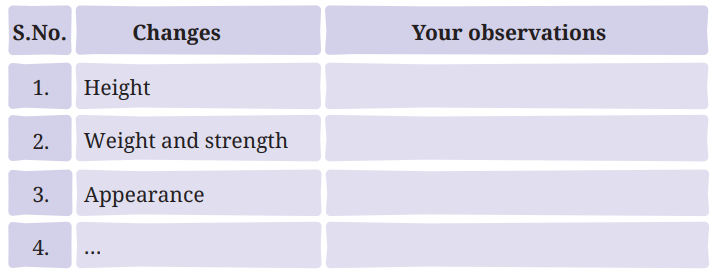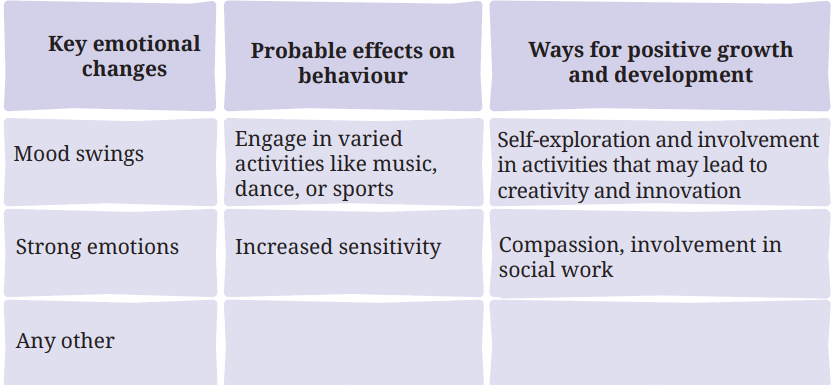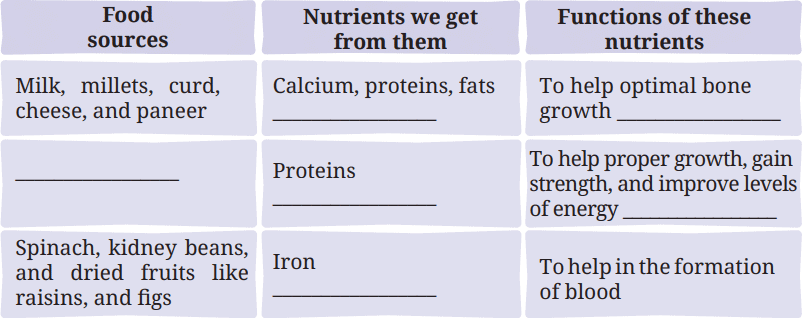Class 7 Science Chapter 6 NCERT Based Activity - Adolescence: A Stage of Growth and Change
| Table of contents |

|
| Activity 6.1: Let us discuss |

|
| Activity 6.2: Let us list |

|
| Activity 6.3: Let us list |

|
| Activity 6.4: Let us spread awareness |

|
Activity 6.1: Let us discuss
- Take a jar and some paper slips.
- Write down the changes you can notice among students as they go from Grades 5 to 8. These could be related to height, strength, behaviour, or any other aspect. Please avoid writing names on the slips.
- Fold the slips and place them in the jar.
- Mix all the slips received from the students in the class and unfold the collected slips one by one. Based on the information on the slips, discuss the changes with the students in the class.
 Table 6.1: Most common changes during growing up
Table 6.1: Most common changes during growing up
1. What were the most commonly observable changes among students, as mentioned on the slips? List these in Table 6.1:
Explanation: The document highlights physical changes like height, weight, and secondary sexual characteristics (e.g., facial hair, breast development, voice changes) during adolescence, typically between ages 10–19 (page 2, page 5). Behavioral changes, such as mood swings, are also noted (page 6). These align with observable changes from Grades 5 to 8 (ages ~10–13). Table 6.1 is completed based on these descriptions and common adolescent changes.
Activity 6.2: Let us list
- Take a moment to think if there are any changes in your emotions or behaviour or that of your classmates and friends in the past one or two years. These changes may be exciting, confusing, or both.
 Table 6.2: Emotional changes, their probable effects on behaviour, and ways for positive growth and development
Table 6.2: Emotional changes, their probable effects on behaviour, and ways for positive growth and development
List some emotional changes in Table 6.2 along with their probable effects on behaviour and ways for positive growth and development:
Explanation: The document notes that adolescence involves stronger emotions affecting behavior, such as mood swings and sensitivity (page 6: “Adolescence is often marked by stronger emotions”). Curiosity and excitement are highlighted as driving new viewpoints (page 7). Seeking independence is a common adolescent trait, influencing behavior (page 6). Positive growth strategies are derived from the document’s emphasis on thoughtful choices and social initiatives (page 6, page 10).
Activity 6.3: Let us list
- Based on the locally available foods, fill Table 6.3 with the healthy food sources, nutrients present in them and how these nutrients can help our growth and development.
 Table 6.3: Food sources, nutrients present in them, and functions of these nutrients
Table 6.3: Food sources, nutrients present in them, and functions of these nutrients
Fill Table 6.3 with the healthy food sources, nutrients present in them and how these nutrients can help our growth and development:

Explanation: The document emphasizes a nutritious diet for adolescence, mentioning proteins, carbohydrates, fats, vitamins, and minerals (page 7). Calcium, proteins, and iron are listed in Table 6.3, with their sources and functions (page 7). Additional foods (e.g., citrus fruits, nuts) are included based on common nutrient sources, supporting adolescent growth (page 8: vitamin B12 for blood health). Vitamin C aids immunity, and B12 supports nerve function, aligning with adolescent needs.
Activity 6.4: Let us spread awareness
- Work in groups to design posters and pamphlets about various aspects of responsible social media behaviour and paste them at designated places in the school. Also, fill in Table 6.4 based on your collective observations.
 Table 6.4: Dos and don'ts to be followed on social media
Table 6.4: Dos and don'ts to be followed on social media
Fill in Table 6.4 based on your collective observations:
Explanation: The document discusses responsible social media use, emphasizing politeness, caution with personal information, and avoiding cyberbullying (page 10: “Be cautious when uploading… sharing personal information”). Table 6.4 is completed with additional guidelines reflecting these principles, such as avoiding harmful content and seeking guidance (page 10: “Seeking guidance from elders and teachers”).
|
80 videos|224 docs|12 tests
|
FAQs on Class 7 Science Chapter 6 NCERT Based Activity - Adolescence: A Stage of Growth and Change
| 1. What is adolescence, and why is it considered a crucial stage of growth? |  |
| 2. What are some common physical changes that occur during adolescence? |  |
| 3. How do emotional changes impact adolescents? |  |
| 4. What role do peers play in an adolescent's life? |  |
| 5. How can parents support their children during adolescence? |  |















